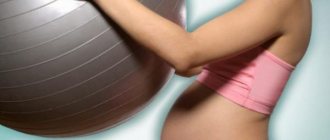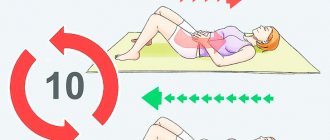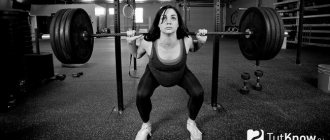What is fitball?
Fitball is a ball. But the ball is special, designed for gymnastic exercises. It's big and bright. Made of special rubber with a built-in Anti-Burst System (ABS - anti-burst system).
Thanks to this same ABS, the fitball does not deflate suddenly and does not burst due to mechanical damage. What protects you from injury while training with a Swiss ball. This is the second name for fitball. Because it was invented in Switzerland.
No matter how much you weigh, you can confidently trust the strength and shock absorption of the fitball.
Exercises on a fitball help strengthen muscles and improve blood supply to all internal organs of a pregnant woman
Harm
In addition to tangible benefits, exercise on the ball can also cause harm.
For woman
Exercising on a ball can harm a pregnant woman if she has chronic diseases. For example, if there is an intervertebral hernia, you can provoke an exacerbation of the pain syndrome by performing twisting movements or bending forward. You can also get various injuries if safety precautions are not followed.
For the baby
An exercise where a woman lies with her back on a fitball and stretches out into an arc can harm both the mother and the unborn child . In this position, the inferior vena cava in the abdominal cavity is compressed, which impairs the flow of blood to the upper body and lowers blood pressure below normal. The fetus at this moment will experience oxygen starvation, which is fraught with serious consequences.
Attention! Also, exercises on a fitball with increased intensity can lead to intrauterine hypoxia and a deterioration in the well-being of a pregnant woman. The best insurance against this is to control your heart rate.
Exercises on a fitball while supporting one leg can cause a pregnant woman to lose balance and fall . The woman may be injured and, depending on the timing of the second trimester, may experience a miscarriage or premature birth.
The advantages of this type of gymnastics
Why should you prefer fitball exercises to other types of gymnastics during pregnancy?
Specialists from various gyms and correctional centers have noted that vibrations during these exercises and the shock-absorbing properties of the Swiss ball have a positive effect on the metabolism of expectant mothers, improve blood circulation in their internal organs and strengthen all muscle groups.
The fitball relaxes, relieves tension, relieves stress on the spinal column, strengthens the muscles of the abdominals, hips, and perineum. Pregnant women need all this not only in order to bear and give birth to a healthy child without any problems, but also for the speedy recovery of already accomplished mothers after childbirth.
And thanks to Kegel exercises, designed to work out the pelvic muscles (which cannot be strengthened in any other way), when the time comes, your baby's head will turn exactly as it needs to in order to pass through the birth canal smoothly.
Since there are a number of contraindications for training with a gymnastic ball, you should consult your doctor before starting them.
What is a fitball used for during pregnancy?
Exercises for pregnant women with a fitball allow the expectant mother to:
- relieve tension from the spine;
- relax the muscles surrounding the spinal column;
- improve the functioning of the respiratory system;
- activate the circulatory system;
- normalize heart function;
- increase blood circulation in all organs.
Exercises with a fitball for pregnant women allow you to keep your pelvic muscles in shape. This makes it possible to minimize the likelihood of injuries and perineal ruptures during childbirth. Such exercises for pregnant women are an effective means of preventing kidney and bladder diseases and uterine prolapse. During exercise, the back and abdominal muscles are strengthened, which is a great advantage during childbirth. Gymnastics with a fitball for pregnant women allows you to improve blood circulation in the uterus and, accordingly, improve the nutrition of the fetus. It helps prevent stagnation of venous blood and the appearance of hemorrhoids.
A fitball for pregnant women will be a good helper in everyday life. It can be used as a chair while watching TV or rocking on it. This allows you to cope with back pain and relax your muscles.
The ball will be useful to the expectant mother during childbirth. It allows you to reduce pain during contractions and use your energy sparingly during this period. With short jumps on a fitball, additional blood flow occurs to the pelvic organs and, due to this, accelerated dilatation of the cervix. Read more about the stages of cervical dilatation →
Exercises on a fitball for pregnant women are recommended to begin after 12 weeks. During this period, the expectant mother is less likely to be bothered by toxicosis, and the likelihood of miscarriage is minimal. Before you start exercises for pregnant women on a fitball, you should consult your doctor. It will be very good if a set of exercises is selected by a competent instructor. It is advisable not to invent them yourself.
Gymnastics on a fitball for pregnant women has a minimum of contraindications, but they still exist. These include:
- threat of miscarriage;
- increased uterine tone;
- severe back diseases;
- isthmic-cervical insufficiency.
Contraindications
But, despite the fact that fitball is quite safe and very effective, there are a number of contraindications for exercising with a Swiss ball.
- Early pregnancy. When there is still a high risk of interruption during physical activity.
- High uterine tone in the expectant mother.
- Severe otropedic or somatic pathologies.
- Istic-cervical insufficiency, etc.
Before you start doing gymnastics on a fitball, you should definitely consult with the gynecologist you are seeing about this. And only after he confirms that you have no history of contraindications to training, can you begin to exercise with a clear conscience.
In order for fitball exercises to produce an effect, you need to take seriously the choice of the ball for yourself.
Fitness for pregnant women
Bent legs should form a right angle
We warn you right away - we are not talking about the fight against excess weight. All physical exercises recommended during pregnancy have the sole purpose of strengthening certain muscle groups. This is exactly the kind of gymnastics you need.
Experts in the field of gynecology and obstetrics advise starting classes in the 2nd trimester of pregnancy. This is due to the fact that if you are in this trimester, then at this time the threat of miscarriage has practically disappeared and, as a rule, toxicosis has passed. And the body begins to experience discomfort due to a significant increase in mass.
In particular, pregnant women experience back pain. So, we need gymnastics. To eliminate this condition, there are exercises on a sports ball - a fitball. First of all, you need to choose it correctly. To begin, simply sit on the ball. If your bent legs form a right angle (as shown in the photo), this is your option.
A set of simple exercises
It is best to start the complex with a warm-up. While sitting on the ball, smoothly tilt your head to one side and the other. Spread your arms and carefully turn your torso to the right and left. Do each exercise several times and move on to the main part.
The main part of the exercises for pregnant women is designed taking into account the fact that in the 2nd trimester the fetus begins to actively grow, and the woman experiences stress on the spine. Gymnastics on a fitball will reduce them.
- Sit on the ball, straight back, arms extended horizontally in front of you. Inhale – bend your left arm at the elbow and move it back, trying to press your shoulder blade against your spine. Exhale – arms in the starting position. Inhale - do the same with your right hand. Exhale – starting position. Be careful - no sudden movements during pregnancy!
- Sitting with a straight back on a fitball, bend your elbows and turn your palms up. Inhale – move your arms to the sides, trying to bring your shoulder blades together. Exhale – starting position.
- Starting position - as described for the first exercise. Exhale – bending your elbows, bend down (no more than 45 degrees!). Inhale – straighten and move your arms back, connecting your shoulder blades. Exhale - straighten up. Inhale – extend your arms forward.
To strengthen the chest muscles, we suggest you familiarize yourself with the variety of exercises shown in the photo. It is performed as follows - bring your arms together on your chest, join your palms and press them forcefully against each other.
Interesting: What Tests Are Needed for a Medical Abortion
The 2nd trimester of pregnancy is considered a safe period. And appropriate gymnastics will minimize physical problems.
- Sit on the ball, straight back, arms extended horizontally in front of you. Inhale – bend your left arm at the elbow and move it back, trying to press your shoulder blade against your spine. Exhale – arms in the starting position. Inhale - do the same with your right hand. Exhale – starting position. Be careful - no sudden movements during pregnancy!
- Sitting with a straight back on a fitball, bend your elbows and turn your palms up. Inhale – move your arms to the sides, trying to bring your shoulder blades together. Exhale – starting position.
- Starting position - as described for the first exercise. Exhale – bending your elbows, bend down (no more than 45 degrees!). Inhale – straighten and move your arms back, connecting your shoulder blades. Exhale - straighten up. Inhale – extend your arms forward.
How to choose a ball for yourself?
Another important point. Wherever you train, at home or in the gym, your training will be effective and safe only if you choose the right gymnastic ball for yourself.
But what does correct mean? Everything is very simple. The fitball should be suitable for your height.
Table “How to choose the right fitball?”
| Height | Gymnastic ball diameter |
| 152 cm and below | 45 cm |
| 152-165 cm | 55 cm |
| 165-185 cm | 65 cm |
You can check if the ball is right for you: sit on it and make sure that with your knees bent at right angles, your legs are freely standing on the floor with your full feet.
Ask the doctor who is observing you if you have a physical therapy room in your clinic, and if there are fitball classes for pregnant women there.
Restrictions
When practicing on the ball, you should remember that for pregnant women in the second trimester there are such restrictions:
- From 16-18 weeks, it is advisable to exercise on the ball in a bandage due to the increase in the size of the uterus. This will reduce the strain on the abdominal and back muscles.
- All exercises must be performed smoothly and slowly, excluding excessive fanaticism and determination.
- The range of movement should be small.
- Your heart rate during exercise should not exceed 130 beats per minute.
- If an exercise causes discomfort, then there is no need to perform it.
- Do not exceed the recommended duration of classes - 30 minutes. It is better to conduct a lesson with underload than to allow overwork.
- Avoid overheating during exercise.
- Do not use training programs for non-pregnant women.
- Do not violate the recommended exercise technique.
Exercises you shouldn't do:
- Lie on the ball with your back, extending your arms straight behind your head, while your body arches.
- Bend your torso forward and to the sides, as well as squat, standing on one leg and placing the other with the side surface of your foot and shin on the ball.
- Lie on your stomach on the fitball.
- Perform intense jumps on the ball.
Fitball exercises for pregnant women
If the antenatal clinic where you are registered has a physical therapy room (physical therapy), then your doctor can write you a referral there. Do not neglect this opportunity to master fitball under the constant supervision of an experienced trainer.
We will now look at the main points that you should pay attention to before starting training.
In the first trimester of pregnancy, physical activity is contraindicated, but you can do stretching and relaxation exercises
First trimester
It is better for pregnant women to start doing gymnastics on a fitball from 12-14 weeks. At this time, the risk of miscarriage is significantly reduced compared to the first weeks of pregnancy. And toxicosis, if any, should no longer bother you so much.
In the first trimester, it is better to limit physical activity for pregnant women. But nothing prevents expectant mothers from doing breathing exercises during this period, which is extremely useful for them, and no less necessary.
If you really can’t wait to start training, then you can work out the hips and muscles of the shoulder girdle, and it’s better to start putting stress on the abs a little later. In the second trimester.
Video “Fitball. Training for pregnant women (1st trimester)"
Second trimester
This is the time that is considered the most favorable for physical activity. You should pay special attention to the pelvic muscles. Kegel exercises help develop them very well, which will be described in more detail below.
From 16-18 weeks of pregnancy it is recommended to train in a bandage. During this period, the pregnant woman's uterus increases significantly in size. The bandage compensates for the load on the spine and abdominal muscles. It also prevents the appearance of stretch marks on the skin.
Video “Fitball. Training for pregnant women (II trimester)"
Third trimester
When the due date gets closer and closer, it becomes quite difficult for the expectant mother to perform even the simplest exercises. But this has nothing to do with fitball. Exercises with him are comfortable, simple and feasible even in the very late stages of pregnancy.
The fitball gymnastics complex includes exercises for the hips, buttocks, arms, and chest. It's not difficult to do them. And the benefits of such activities are enormous.
The third trimester is the time when you prepare for the upcoming birth.
Moreover, many maternity hospitals today have gymnastic balls. And many women in labor confirm that they significantly help them during the birth process.
Doctors note that, indeed, in women the process of opening the uterus during childbirth occurs much faster when they use a gymnastic ball during contractions and, most importantly, know what to do with it.
In the third trimester of pregnancy, expectant mothers learn all the intricacies of using a fitball during childbirth.
Video “Fitball. Training for pregnant women (III trimester)"
Fitball exercises for pregnant women can be divided into three groups.
- Stretching exercises and also to strengthen muscles.
- To relax.
- Exercises on a fitball using the Kegel technique.
How to perform one or another type of gymnastics for pregnant women on a Swiss ball?
Photo gallery “Fitball for expectant mothers”
For stretching and strengthening muscles
- Stretching exercise. Which will be very useful to you during childbirth. While sitting on the ball, spread your knees and place your feet wider. Reach your right hand towards your left foot and vice versa, shifting your pelvis in the opposite direction. At the same time, the muscles of the hips, back, and shoulder girdle are actively stretched. Which is exactly what you need.
- For the muscles of the back and lower back. You need to sit on the ball. You can lean on it with your hands if you have not yet learned how to maintain your balance. Make rocking movements with your pelvis, first from side to side. Then back and forth. And then - rotational movements of the pelvis, first in one direction, then in the other. This exercise can later be done during childbirth. It will help you take your mind off pain, relax and rest between contractions. It also promotes the speedy opening of the cervix during childbirth.
- For the muscles of the hips and legs. Sit on the floor and spread your knees as wide as possible. Place the ball between your knees and squeeze the fitball with them as tightly as possible, periodically loosening your grip. Repeat this several times.
- For the muscles of the shoulder girdle. Squeeze the ball with your arms outstretched. Alternately tighten your grip and loosen it. You can also roll the ball back and forth across the floor, moving it away from you as much as possible, then bringing it closer.
- For buttocks and lower back. Rest your chest on the ball while kneeling. Place your body weight on the stability ball. Cross your hands under your chin. Swing your legs one at a time.
- For the abdominal muscles. In a sitting position, rest your back on the ball. Make sure your shoulder blades are resting on the exercise ball and your knees are bent at right angles. Hands behind head. Raise your torso and hold the position for several seconds. Significant stress on the abdominal muscles is not recommended for pregnant women. But this exercise is not contraindicated for them. And it perfectly strengthens the abs and lower back muscles.
Exercises to strengthen muscles and stretch them, if performed on a fitball, are more effective
For relaxation
By learning to relax on a fitball, you will be one hundred percent prepared for the upcoming birth. Try lying on the ball with your chest while sitting next to it on your knees. Hug the fitball with your hands and relax your back. At the same time, the blood circulation of your internal organs, and with them the placenta, will significantly improve.
This position will give you the opportunity to rest between contractions during labor. And for the baby, this is a great opportunity to get more oxygen, which he so needs during the birth process.
If you learn to take a comfortable position for relaxation on an exercise ball, this will help you recover between contractions during labor.
Kegel exercises
In the pelvic area there is a system of multi-layered muscles, which during childbirth are responsible for turning the baby's head inside the birth canal. Without turning appropriately, the child’s head simply will not be able to pass through them.
We can completely control these muscles. Only in everyday life do we use our skill, perhaps only to control the act of urination.
That is why the multi-layered muscles of the small pelvis are not very well developed in most women. And in order to bring her to the state necessary for the birth process, you need to perform special exercises.
A set of exercises to strengthen the pelvic floor muscles was developed by the American gynecologist Arnold Kegel in the mid-twentieth century.
Kegel exercises train the pelvic floor muscles
What are the exercises included in it?
- You can most easily feel the multi-layered muscles that you need to strengthen during your next urination. Just try to control it. And remember at the same time which muscles you used to hold back the stream of urine or, conversely, increase its pressure.
- Next, you need to learn how to squeeze these deep muscles from bottom to top and top to bottom (imagine that an elevator is moving along its shaft), making 4 pauses.
- Such exercises are much more effective on a fitball. But you can do them without a ball - in a normal home environment.
What gymnastics are recommended in the second trimester of pregnancy (photo and video tips)
If you are expecting a baby, we sincerely congratulate you! A new life is now developing in you. And what it will be like depends entirely on you. During pregnancy, the whole world revolves around and takes on new colors. You are the center of the universe. In the first trimester, you probably studied special literature and watched educational videos for pregnant women. After which we understood the basic rules - the expectant mother must:
- eat properly and balanced;
- stay calm and have a positive attitude;
- prepare for the upcoming birth.
What does it mean? It is necessary to master a set of exercises designed specifically for pregnant women. This is best done in the 2nd trimester.
What do you need to practice on the ball at home?
The greatest benefit will come from practicing on a ball that is correctly sized . This is necessary so that the angle between the thighs and shins of a pregnant woman sitting on a fitball is 90º.
The diameter of the ball is determined by a simple formula:
woman's height in centimeters minus 100 = ball diameter
So, with the growth of the expectant mother at 165-170 cm, the diameter of the sports equipment is 65 cm.
General recommendations for conducting exercises on fitball are as follows::
- You should train 2-3 times a week. At first, the duration of the lesson should be 10-15 minutes. Further, as you train, the time can be gradually increased, bringing it to 30 minutes.
- You need to exercise in sports shoes or barefoot so that your feet do not slip.
- Before the main exercises on a fitball, it is useful to do a short warm-up.
- At first, it is not necessary to do all the exercises in the complex. Do the ones that seem easiest first. As the body gets into the training mode, you can do all the exercises, increasing the time for each.
Prohibited exercise techniques in the second trimester
During pregnancy, including in its second trimester, the following types of physical activity are prohibited:
- abdominal exercises;
Abdominal exercises - serious physical activity
- jumping;
- strength exercises (with lifting heavy equipment);
Strength exercises are dangerous during pregnancy
- team sports games;
- run.
Performing exercises that are prohibited during pregnancy can cause irreparable harm to the health of the expectant mother and also endanger the life of the fetus.
The most popular questions about fitball and their answers
A fitball appeared - and a lot of questions immediately arose regarding it. Here are the most common ones, along with their answers.
What to inflate with?
1
Electric, hand or foot pumps can be used for this purpose. And even just with your mouth, like an ordinary ball or inflatable toy. In this case, it is better for expectant mothers not to strain themselves, but to ask their husband or someone else. To what extent should I inflate?
2
It’s important not to overdo it here, because if the fitball is overinflated, it will become hard and you won’t be able to sit comfortably on it or maintain your balance. A weakly inflated fitball is too soft and not as effective. If it is inflated correctly, the ball will be elastic and will spring back well. How to store?
3
If there is not enough free space, the fitball is inflated for the duration of the class, and then lowered. Although manufacturers still recommend storing the gymnastic ball in an inflated state. You can keep it in the room, hidden under the table, so that it doesn’t roll around or get in the way. You can even hide the fitball in a closet or store it on the balcony. The main thing is to avoid direct sunlight and do not leave it near heated devices - radiators or heaters. How to care?
4
Caring for this ball is not difficult. Branded products have high antistatic properties and do not attract dust and small debris. A dirty fitball is wiped with a soft cloth, if necessary, moistened with a soap solution. In general, it must be treated with care and used for activities on a smooth surface without uneven surfaces. Is repair possible?
5
The possibility and feasibility of repair depends on the degree of damage. A ball with holes can be sealed or taken to a tire shop for repairs. For more serious injuries, if the patch is expected to be large, this is hardly advisable, since exercising on such a fitball will be inconvenient.










